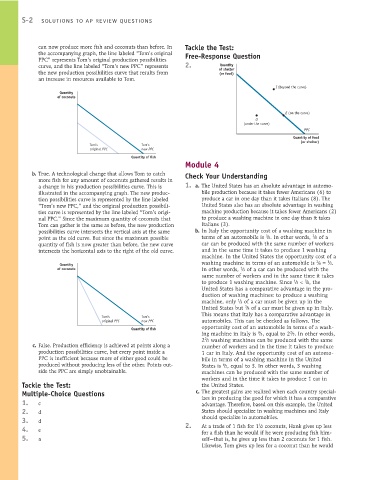Page 848 - Krugmans Economics for AP Text Book_Neat
P. 848
S-2 SOLUTIONS TO AP REVIEW QUESTIONS
can now produce more fish and coconuts than before. In Tackle the Test:
the accompanying graph, the line labeled “Tom’s original Free-Response Question
PPC” represents Tom’s original production possibilities
curve, and the line labeled “Tom’s new PPC” represents 2. Quantity
of shelter
the new production possibilities curve that results from (or food)
an increase in resources available to Tom.
I (beyond the curve)
Quantity
of coconuts
E (on the curve)
U
(under the curve)
PPC
Quantity of food
(or shelter)
Tom’s Tom’s
original PPC new PPC
Quantity of fish
Module 4
b. True. A technological change that allows Tom to catch Check Your Understanding
more fish for any amount of coconuts gathered results in
a change in his production possibilities curve. This is 1. a. The United States has an absolute advantage in automo-
illustrated in the accompanying graph. The new produc- bile production because it takes fewer Americans (6) to
tion possibilities curve is represented by the line labeled produce a car in one day than it takes Italians (8). The
“Tom’s new PPC,” and the original production possibili- United States also has an absolute advantage in washing
ties curve is represented by the line labeled “Tom’s origi- machine production because it takes fewer Americans (2)
nal PPC.” Since the maximum quantity of coconuts that to produce a washing machine in one day than it takes
Tom can gather is the same as before, the new production Italians (3).
possibilities curve intersects the vertical axis at the same b. In Italy the opportunity cost of a washing machine in
3
3
point as the old curve. But since the maximum possible terms of an automobile is ⁄8. In other words, ⁄8 of a
quantity of fish is now greater than before, the new curve car can be produced with the same number of workers
intersects the horizontal axis to the right of the old curve. and in the same time it takes to produce 1 washing
machine. In the United States the opportunity cost of a
2
1
Quantity washing machine in terms of an automobile is ⁄6 = ⁄3.
1
of coconuts In other words, ⁄3 of a car can be produced with the
same number of workers and in the same time it takes
1
3
to produce 1 washing machine. Since ⁄3 < ⁄8, the
United States has a comparative advantage in the pro-
duction of washing machines: to produce a washing
1
machine, only ⁄3 of a car must be given up in the
3
United States but ⁄8 of a car must be given up in Italy.
Tom’s Tom’s This means that Italy has a comparative advantage in
original PPC new PPC automobiles. This can be checked as follows. The
opportunity cost of an automobile in terms of a wash-
Quantity of fish
8
2
ing machine in Italy is ⁄3, equal to 2 ⁄3. In other words,
2
2 ⁄3 washing machines can be produced with the same
c. False. Production efficiency is achieved at points along a number of workers and in the time it takes to produce
production possibilities curve, but every point inside a 1 car in Italy. And the opportunity cost of an automo-
PPC is inefficient because more of either good could be bile in terms of a washing machine in the United
produced without producing less of the other. Points out- States is ⁄2, equal to 3. In other words, 3 washing
6
side the PPC are simply unobtainable. machines can be produced with the same number of
workers and in the time it takes to produce 1 car in
Tackle the Test: the United States.
Multiple-Choice Questions c. The greatest gains are realized when each country special-
1. c izes in producing the good for which it has a comparative
advantage. Therefore, based on this example, the United
2. d States should specialize in washing machines and Italy
3. d should specialize in automobiles.
1
4. e 2. At a trade of 1 fish for 1 ⁄2 coconuts, Hank gives up less
for a fish than he would if he were producing fish him-
5. a self—that is, he gives up less than 2 coconuts for 1 fish.
Likewise, Tom gives up less for a coconut than he would

